Jan Drchal
Claim Extraction for Fact-Checking: Data, Models, and Automated Metrics
Feb 07, 2025



Abstract:In this paper, we explore the problem of Claim Extraction using one-to-many text generation methods, comparing LLMs, small summarization models finetuned for the task, and a previous NER-centric baseline QACG. As the current publications on Claim Extraction, Fact Extraction, Claim Generation and Check-worthy Claim Detection are quite scattered in their means and terminology, we compile their common objectives, releasing the FEVERFact dataset, with 17K atomic factual claims extracted from 4K contextualised Wikipedia sentences, adapted from the original FEVER. We compile the known objectives into an Evaluation framework of: Atomicity, Fluency, Decontextualization, Faithfulness checked for each generated claim separately, and Focus and Coverage measured against the full set of predicted claims for a single input. For each metric, we implement a scale using a reduction to an already-explored NLP task. We validate our metrics against human grading of generic claims, to see that the model ranking on $F_{fact}$, our hardest metric, did not change and the evaluation framework approximates human grading very closely in terms of $F_1$ and RMSE.
AIC CTU system at AVeriTeC: Re-framing automated fact-checking as a simple RAG task
Oct 15, 2024Abstract:This paper describes our $3^{rd}$ place submission in the AVeriTeC shared task in which we attempted to address the challenge of fact-checking with evidence retrieved in the wild using a simple scheme of Retrieval-Augmented Generation (RAG) designed for the task, leveraging the predictive power of Large Language Models. We release our codebase and explain its two modules - the Retriever and the Evidence & Label generator - in detail, justifying their features such as MMR-reranking and Likert-scale confidence estimation. We evaluate our solution on AVeriTeC dev and test set and interpret the results, picking the GPT-4o as the most appropriate model for our pipeline at the time of our publication, with Llama 3.1 70B being a promising open-source alternative. We perform an empirical error analysis to see that faults in our predictions often coincide with noise in the data or ambiguous fact-checks, provoking further research and data augmentation.
Pipeline and Dataset Generation for Automated Fact-checking in Almost Any Language
Dec 15, 2023Abstract:This article presents a pipeline for automated fact-checking leveraging publicly available Language Models and data. The objective is to assess the accuracy of textual claims using evidence from a ground-truth evidence corpus. The pipeline consists of two main modules -- the evidence retrieval and the claim veracity evaluation. Our primary focus is on the ease of deployment in various languages that remain unexplored in the field of automated fact-checking. Unlike most similar pipelines, which work with evidence sentences, our pipeline processes data on a paragraph level, simplifying the overall architecture and data requirements. Given the high cost of annotating language-specific fact-checking training data, our solution builds on the Question Answering for Claim Generation (QACG) method, which we adapt and use to generate the data for all models of the pipeline. Our strategy enables the introduction of new languages through machine translation of only two fixed datasets of moderate size. Subsequently, any number of training samples can be generated based on an evidence corpus in the target language. We provide open access to all data and fine-tuned models for Czech, English, Polish, and Slovak pipelines, as well as to our codebase that may be used to reproduce the results.We comprehensively evaluate the pipelines for all four languages, including human annotations and per-sample difficulty assessment using Pointwise V-information. The presented experiments are based on full Wikipedia snapshots to promote reproducibility. To facilitate implementation and user interaction, we develop the FactSearch application featuring the proposed pipeline and the preliminary feedback on its performance.
CsFEVER and CTKFacts: Czech Datasets for Fact Verification
Jan 31, 2022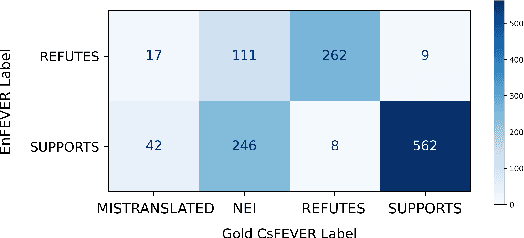



Abstract:In this paper, we present two Czech datasets for automated fact-checking, which is a task commonly modeled as a classification of textual claim veracity w.r.t. a corpus of trusted ground truths. We consider 3 classes: SUPPORTS, REFUTES complemented with evidence documents or NEI (Not Enough Info) alone. Our first dataset, CsFEVER, has 127,328 claims. It is an automatically generated Czech version of the large-scale FEVER dataset built on top of Wikipedia corpus. We take a hybrid approach of machine translation and document alignment; the approach, and the tools we provide, can be easily applied to other languages. The second dataset, CTKFacts of 3,097 claims, is annotated using the corpus of 2.2M articles of Czech News Agency. We present its extended annotation methodology based on the FEVER approach. We analyze both datasets for spurious cues - annotation patterns leading to model overfitting. CTKFacts is further examined for inter-annotator agreement, thoroughly cleaned, and a typology of common annotator errors is extracted. Finally, we provide baseline models for all stages of the fact-checking pipeline.
WiSM: Windowing Surrogate Model for Evaluation of Curvature-Constrained Tours with Dubins vehicle
Feb 03, 2020
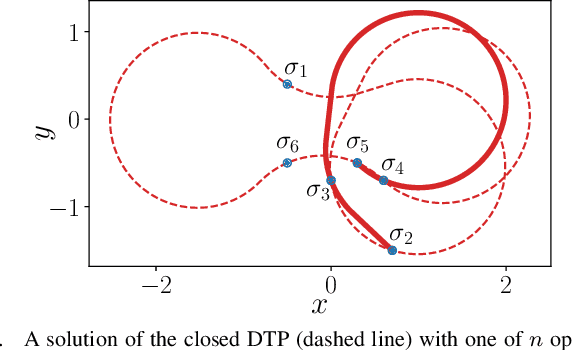
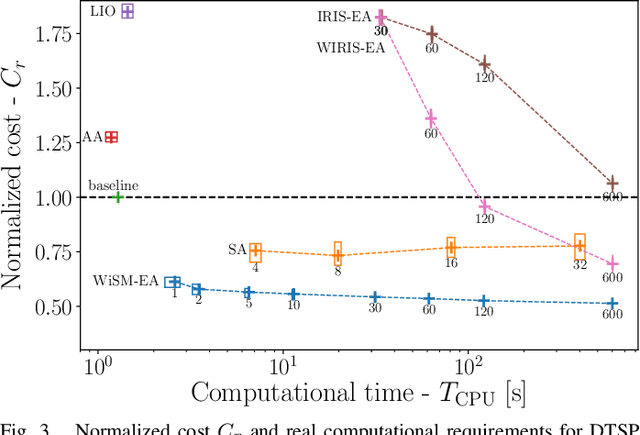
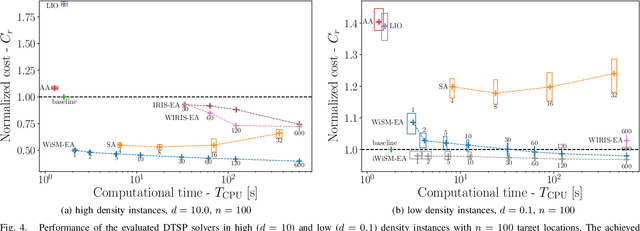
Abstract:Dubins tours represent a solution of the Dubins Traveling Salesman Problem (DTSP) that is a variant of the optimization routing problem to determine a curvature-constrained shortest path to visit a set of locations such that the path is feasible for Dubins vehicle, which moves only forward and has a limited turning radius. The DTSP combines the NP-hard combinatorial optimization to determine the optimal sequence of visits to the locations, as in the regular TSP, with the continuous optimization of the heading angles at the locations, where the optimal heading values depend on the sequence of visits and vice versa. We address the computationally challenging DTSP by fast evaluation of the sequence of visits by the proposed Windowing Surrogate Model (WiSM) which estimates the length of the optimal Dubins path connecting a sequence of locations in a Dubins tour. The estimation is sped up by a regression model trained using close to optimum solutions of small Dubins tours that are generalized for large-scale instances of the addressed DTSP utilizing the sliding window technique and a cache for already computed results. The reported results support that the proposed WiSM enables a fast convergence of a relatively simple evolutionary algorithm to high-quality solutions of the DTSP. We show that with an increasing number of locations, our algorithm scales significantly better than other state-of-the-art DTSP solvers.
Liftago On-Demand Transport Dataset and Market Formation Algorithm Based on Machine Learning
Aug 09, 2016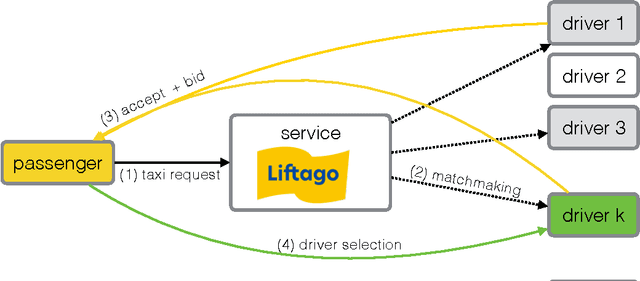
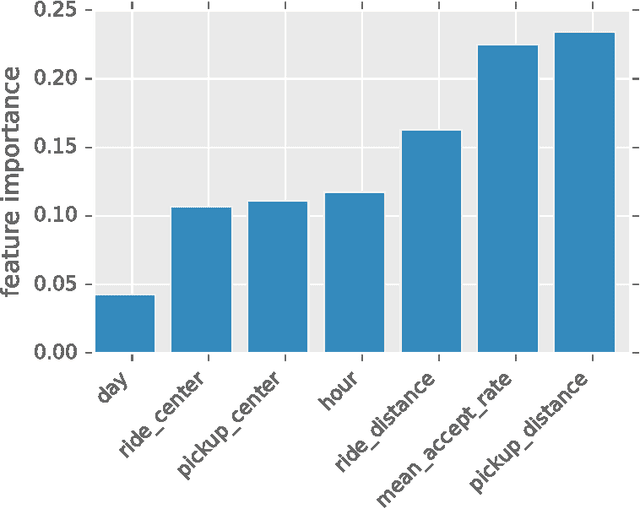
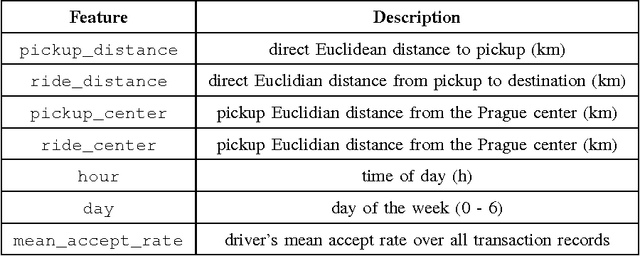
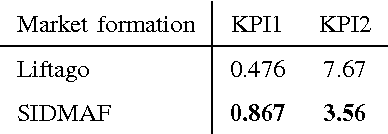
Abstract:This document serves as a technical report for the analysis of on-demand transport dataset. Moreover we show how the dataset can be used to develop a market formation algorithm based on machine learning. Data used in this work comes from Liftago, a Prague based company which connects taxi drivers and customers through a smartphone app. The dataset is analysed from the machine-learning perspective: we give an overview of features available as well as results of feature ranking. Later we propose the SImple Data-driven MArket Formation (SIDMAF) algorithm which aims to improve a relevance while connecting customers with relevant drivers. We compare the heuristics currently used by Liftago with SIDMAF using two key performance indicators.
 Add to Chrome
Add to Chrome Add to Firefox
Add to Firefox Add to Edge
Add to Edge